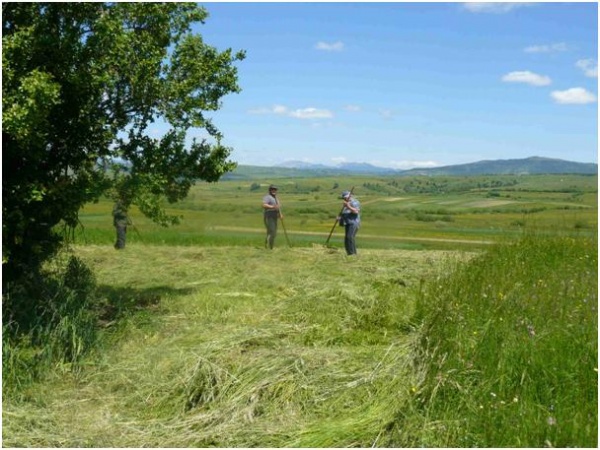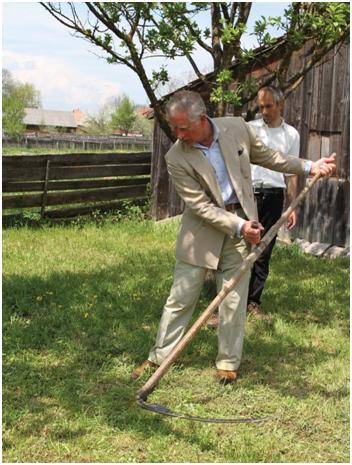References: References and bibliography
Small scale farming in the Pogány-havas Region of Transylvania
Sólyom Andrea, Barbara Knowles, Bogdán Janka, Rodics Gergely, Biró Róbert, Nyírő Gergely
Report based on a multi-faceted social research project carried out by the Pogány-havas Association in 2011. The main aim was to gain a comprehensive and evidence based picture about the family-farming system of the area, the farmers’ main concerns, problems and future plans, which provides data to work out proper interventions on local, regional, national and EU level. This study was also a reference for developing proposals to national and EU policy makers.
http://efncp.org/projects/projects-in-romania/poganyhavas/
and
Small scale farming in the Pogány-havas Region of Transylvania: Summary, conclusions and policy recommendations
Sólyom Andrea, Barbara Knowles, Bogdán Janka, Rodics Gergely, Biró Róbert, Nyírő Gergely
Multidimensionality and scale in a landscape: ethnoecological partitioning of a mountainous landscape (Gyimes, Eastern Carpathians, Romania)
Dániel Babai and Zsolt Molnár
Traditional habitat knowledge is an understudied part of traditional knowledge. Though the number
of studies increased world-wide in the last decade, this knowledge is still rarely studied in Europe. We document the habitat vocabulary used by Csángó people, and determine features they used to name and describe these categories.
Journal of Ethnobiology and Ethnomedicine 2013, 9:11
Mountain Hay Meadows: the Romanian Context and the Effects of Policy on High Nature Value Farming
Barbara Knowles
In this paper I provide a context and background for this publication, and consider issues of national and European policy that affect meadow ecosystems in Romania.
I describe the benefits for Romania of allowing as many as possible of its small-scale farmers to continue managing the land in an environmentally sustainable manner through traditional methods which create and maintain a mosaic landscape that is highly beneficial to biodiversity.
In addition to the many ecosystem services provided by traditional extensive agriculture, these farmers provide food, social stability and meaningful work for their families and communities. The state cannot afford to pay for these free goods and services provided by semi subsistence farmers.
The current reformulation of the Common Agricultural Policy provides an opportunity for change. Policymakers should re-examine what they mean by efficiency in agriculture, and include environmental and social costs and benefits on the balance sheet alongside the economic ones.
Much more could be done by local, national and European government to ensure that the smallholders of Romania can have an economically sustainable future while maintaining their socially, culturally and environmentally valuable way of life.
http://www.mountainhaymeadows.eu/online_publication/02-mountain-hay-meadows-the-romanian-context-and-the-effects-of-policy-on-high-nature-value-farming.html
Natural Treasures of the Csík Basin (Depresiunea Cicului) and Csík Mountains (Munţii Ciucului)
László DEMETER, Anna-Mária CSERGŐ, Attila D. SÁNDOR, István IMECS, Csaba T. VIZAUER
In this paper we make an attempt to identify the characteristic natural features of two neighbouring, but geographically, ecologically and culturally distinct areas of the Eastern Carpathians. The Csík Basin is one of the large tectonic mountain basins of the Eastern Carpathians and the Csík Mountains are part of the Carpathian flysch. The most characteristic habitats of the basin are fens and other types of wetland habitats. The fens host a large number of boreal and glacial relic plant species and represent the southern limit of the global distribution of some plant and butterfly species. The other wetland habitats are important for specialized invertebrates, fish, amphibians and birds. Most wetlands, especially the main river and its floodplain were heavily degraded in the past five decades. The characteristic features of the mountains are the secondary grasslands that were created by and for traditional agriculture in the past two to three centuries. Especially the higher altitude hay meadows have an outstanding plant species richness. We argue that although several habitat types have been severely degraded, significant parts of the area are still in a good ecological condition, having many natural features that are typical. We recommend the usage of these features by rural developers in shaping local identity for a more aware usage of natural resources and better integration of local society in the ecosystem.
http://www.mountainhaymeadows.eu/online_publication/03-natural-treasures-of-the-csik-basin-and-csik-mountains.html
Farming and Management of Hay Meadows in Csík and Gyimes – Experiences from Social Research
Róbert BIRÓ, László DEMETER, Barbara KNOWLES
Within a hay meadow research and conservation programme in the Eastern Carpathians of Romania, we conducted a sociological survey between January and March 2010 on the two demonstration sites of the project, Delne and Hidegség.
From the information gathered during this research our conclusions are:
• many farmers in the mountain village still hold on to traditional methods of farming, but there is an everyday struggle to keep this alive; while closer to the city, traditional farming is declining to a greater extent;
• the biggest challenge that farmers face is selling products.
If no viable solutions are found in this issue, traditional agriculture will continue to decline.
http://www.mountainhaymeadows.eu/online_publication/11-farming-and-management-of-hay-meadows-in-csik-and-gyimes.html
Supporting Agriculture, Tradition and Ecosystems in the Pogány-havas Microregion of Transylvania (Romania)
Gergely RODICS and Barbara KNOWLES
We describe an integrated programme to improve rural incomes, support traditional agriculture, understand the ecology and biology of mountain hay meadows, and identify and protect key species and habitats in need of conservation.
http://www.mountainhaymeadows.eu/online_publication/15-supporting-agriculture-tradition-and-ecosystems-in-the-pogany-havas-microregion-of-transylvania.html
Quantifying the abandonment of mountain hay meadows in the Eastern Carpathians
László Demeter, Alpár Kelemen
We mapped 34.2 km2 of hay meadows, of which 11.85% (4.05 km2) have been mown in 2011. Szépvíz commune has the largest amount of mountain hay meadows, and largest amount of mown mountain meadows; Pálfalva commune has the smallest amount of mown meadows (about 1% of the meadows) while in Felsőlok the amount of mown meadows is 0.5% larger than that of the unmown meadows. Szépvíz and Pálfalva communes have the largest amount of unmown meadows.
As a general pattern, it can be observed that mowing is restricted to places with easier access – along main roads and valley bottoms. The main area of mowing is the surroundings of the Gyimes Pass, a contact zone between the Csík and Gyimes areas, with different land use patterns.
Report for European Forum on Nature Conservation and Pastoralism (EFNCP), 2011
http://efncp.org/projects/projects-in-romania/poganyhavas/
Ecosystem services of mown, grazed and abandoned grasslands in the Csík Mountains, EasternCarpathian Mountains, Romania
Anna Mária Csergő, László Demeter
Measuring ecosystem services is becoming a useful tool for people to understand the value of nature and also of HNV farmland. In this study we analyze several ecosystem services provided by grasslands in the Csík Mountains, Eastern Carpathians, like animal fodder, medicinal substances, pollination, nitrogen fixation and nature conservation. The analysis is based on data collected in the field about plant species composition and abundance (cover) and ecological indices available in the literature.
Mountain hay meadows have the highest frequency of several provisioning services like health and well-being, honey- and pollen provision and other genetic resources (toxic plants) in our study system. Mowing has also generated exceptionally high species diversity in our study area and elsewhere in Eastern Europe. Because most provisioning services were positively correlated with species richness, it results that the wider variety of species that provide different ecosystem services in mowed meadows is a direct consequence of these meadows higher plant diversity.
Our data represent strong evidence that low intensity mowing which may include short-term abandonment episodes coupled with the traditional seasonal light grazing (in autumn) is the best practice to produce and maintain a high variety of ecosystem services.
http://efncp.org/projects/projects-in-romania/poganyhavas/
Butterfly diversity of meadows and pastures in the Csík mountains
László Demeter and colleagues
There are very few published data about the butterfly diversity of the Csík mountains. The goal of our study was to quantify diversity and to relate it do main land use types, i.e. meadows and pastures. Currently, pastures and meadows benefit from the same amount of agri-environment payments, but their ecological value is not properly assessed.
Our data suggest that there is a strong difference between meadows and pastures in terms of butterfly diversity, and that meadows have higher value for butterfly diversity than pastures. Agri-environment schemes should be designed to reflect this difference. The present scheme clearly favors pastures. On the long term, conversion of meadows to pastures is a threat to butterfly diversity in our study area. We recommend different levels of payment for meadows and pastures and / or strict rules on stocking density on pastures.
http://efncp.org/projects/projects-in-romania/poganyhavas/
High plant species diversity is explained by traditional management, environment and dominant species identity in grasslands of the Eastern Carpathians
Anna Mária Csergő, László Demeter
The present study assesses the effect of two land use types: grazing and mowing, respectively abandonment on plant diversity.
The results show important species loss following abandonment. Severity of impact depends on the vegetation type, being higher in vegetation dominated by Tor-grass (Brachypodium pinnatum). Clear differences in plant diversity patterns were revealed between hay meadows and pastures, hay meadows being richer and more evenly structured. Moreover, high altitude hay meadows are more diverse than the low altitude meadows. It is noteworthy that other abiotic conditions (moisture, slope, heat load) are additional modulators of floristic diversity in this area. In the light of our results, maintenance of traditional land-use practices is likely the most effective tool of biodiversity conservation in the area.
Therefore, we recommend a separation of hay meadows and pastures in the agricultural policies on the basis of plant diversity patterns, as an ecological output of land management, i.e. higher payments for hay meadows. Otherwise there is a risk of conversion from hay meadows to pastures. On the other hand, the problem of abandonment should be specifically addressed by agri-environment policies. The logic of payments should be not so much compensation for loss, but prevention of abandonment.
http://efncp.org/projects/projects-in-romania/poganyhavas/
Figures, tables and photos: All figures, tables and photos should be cited in the text
Website links: Related website links such as of organisations and projects
Pogány-havas Association: www.poganyhavas.ro
Barbara Knowles Fund www.treasuresoftransylvania.org
Hay meadows: www.mountainhaymeadows.eu
Recommendation: Citations for recommended readings related to the case study







